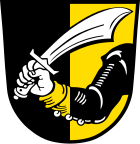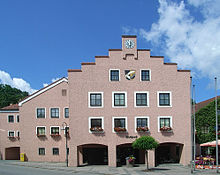Arnstorf
| coat of arms | Germany map | |
|---|---|---|

|
Coordinates: 48 ° 34 ' N , 12 ° 49' E |
|
| Basic data | ||
| State : | Bavaria | |
| Administrative region : | Lower Bavaria | |
| County : | Rottal Inn | |
| Height : | 397 m above sea level NHN | |
| Area : | 80.43 km 2 | |
| Residents: | 7148 (Dec. 31, 2019) | |
| Population density : | 89 inhabitants per km 2 | |
| Postal code : | 94424 | |
| Area code : | 08723 | |
| License plate : | PAN, EG, GRI, VIB | |
| Community key : | 09 2 77 111 | |
| LOCODE : | DE AOR | |
| Market structure: | 151 districts | |
Market administration address : |
Marktplatz 8 94424 Arnstorf |
|
| Website : | ||
| First Mayor : | Christoph Brunner (LWG) | |
| Location of the Arnstorf market in the Rottal-Inn district | ||
Arnstorf is a market in the Lower Bavarian district of Rottal-Inn .
geography
Geographical location
The market is located on the Kollbach in the Landshut region in the middle of the Lower Bavarian hilly landscape , about 20 km south of Landau , 29 km east of Dingolfing , 22 km northeast of Eggenfelden , 18 km north of Pfarrkirchen and 32 km west of Vilshofen , a few kilometers from the Bundesstrasse 20 away. The closest train stations are in Landau an der Isar and Pfarrkirchen.
Community structure
Districts
There are 151 districts:
Markings
The nine municipalities of Markt Arnstorf include Arnstorf, Hainberg, Jägerndorf, Kohlstorf, Mariakirchen, Mitterhausen, Ruppertskirchen, Sattlern and Unterhöft .
history

Until the 19th century
Arnstorf was first mentioned in a document in 1145. Arnstorf belonged to the Freiherr von Closen from the 13th century until 1847 and was under Bavarian sovereignty.
The Arnstorfer Closen were judges and landlords as court lords. They exercised the "rule" over the land and people in their area of ownership and had the right to flock as well as the sole right to hunt and fish. They approved the guild and craft regulations. They were endowed with the right of patronage . In 1419 they achieved that Arnstorf was raised to market rights by the Bavarian dukes Ernst and Wilhelm .
With the market survey (with the consent of the Eggenfelden and Pfarrkirchen markets) the right to hold annual markets was connected. With the granting of market rights, the economic basis for the market was given and subsequently enabled the residents to engage in commercial and industrial activities. The delimitation of the various legal competencies was often controversial here, as Arnstorf had market rights, was the seat of a closed Hofmark and was also in three different high court areas ( Eggenfelden , Reichenbach and Landau district court ).
When the community was formed in 1818 by the community edict in Bavaria, the patrimonial court of Arnstorf of the barons of Closen enforced the patrimonial constitution of the market itself and the communities of Jägerndorf and Hainberg against the Eggenfelden district court . After the death of Countess Agnes von Koenigsfeld (née Countess Closen), the Countess Koenigsfeld-Closen'sche Patrimonial Court of Arnstorf passed to the Counts von Deym through marriage in 1847. In 1848, however, the Arnstorf Patrimonial Court was dissolved in Germany during the 1848/1849 revolution .
By ordinance of February 24, 1862, the municipality of Arnstorf was spun off from the Eggenfelden Regional Court and assigned to the Arnstorf Regional Court, newly established in 1861 , which together with the Eggenfelden Regional Court formed the Eggenfelden District Office .
20th century
In 1933 Arnstorf had 1734 inhabitants. The Eggenfelden district emerged from the Eggenfelden district office in 1939 . Since the dissolution of the Arnstorf District Court on June 15, 1943, Arnstorf has belonged to the Eggenfelden District Court .
In 1903 Arnstorf received a railway connection with the opening of the Landau – Arnstorf railway line. The route was closed in 1994, and a cycle path has been running on its route since 1999.
Incorporations
On January 1, 1972, the previously independent communities of Hainberg and Ruppertskirchen as well as parts of Mitterhausen and Unterhöft were incorporated. Jägerndorf followed on July 1, 1972. Kohlstorf and Mariakirchen followed on May 1, 1978.
Assignments
On January 1, 1975, an area with about 100 inhabitants was assigned to the neighboring municipality of Malgersdorf .
Population development
Between 1988 and 2018 the market grew from 5,584 to 6,978 by 1,394 inhabitants or 25%.
politics
Market council
The market council consists of the 1st mayor and 20 market council members. The 2020 local elections resulted in the following allocation of seats in the market council:
| 2020 | 2014 | |
|---|---|---|
| CSU | ||
| LWG Mariakirchen | 2 | 3 |
| SPD | 2 | |
| LWG Ruppertskirchen | 2 | |
| LWG Jägerndorf | 2 | |
| LWG Mitterhausen | 2 | |
| UWG | 2 | |
| Young generation | 1 | |
| LWG Hainberg-Neukirchen | 1 | |
| total | 20th | 20th |
mayor
Christoph Brunner has been mayor since May 2020.
coat of arms
Blazon : In a cautious of black and gold split plate from left vorbrechender, dressed in colors mistook arm, a silver sword with a gold handle.
Explanation: The saber-swinging arm is said to represent an old imperial symbol for market peace, the colors are those of the coat of arms of the von Closen (noble family) .
Town twinning
- Rossatz-Arnsdorf , Lower Austria
- Eybens, France
Culture and sights
Buildings
- Arnstorf is first mentioned as a parish in 1253. The current church was built in the 15th century in the late Gothic style. The Gothic interior was followed by a Baroque interior.
- Snow chapel
- Already around the time of the Thirty Years' War there was a cross column at the place where the " Maria Schnee " chapel was built later, where Arnstorfer entrusted their concerns of Mary's intercession. The year of construction and the builder of the snow chapel are unknown. The approximate construction time can be calculated on the basis of the loaned capital from the Kapellenstiftung to the period between 1723 and 1730.
- The "Alt-Arnstorf-Haus"
- In 1980, an association committed to local history made the log house (18th century) with attached stable and barn of the "Eckflez House" type accessible as a museum. In it he exhibits furniture, household items and agricultural implements. A fully equipped shoemaker's workshop gives an insight into the craft life of bygone times. Since 1993, the Arnstorf photographer Joseph Gollwitzer's collection of 25,000 glass negatives has been inventoried and archived.
- In the 15th century moated castle, which was removed from the market, the imperial barons of Closen created a representative aristocratic residence. The castle passed into the possession of Count Deym through marriage in the 19th century . Two state rooms, including the so-called Kaisersaal, were decorated with mythological scenes by Melchior Steidl in 1714. The fresco artist was not only familiar with the baroque art of Rome, but had also worked at the best royal courts. A private theater was built into the smaller of the two state rooms in the 19th century, in keeping with the zeitgeist of the time. The St. Katharina Castle Chapel with a ceiling fresco by Steidl was redesigned in 1715. The group of horsemen of St. The dragon fighter Georg comes from the former high altar of the parish church and is attributed to Johann Christoph Bendl .
- After the imperial barons of Closen had agreed on a division of the rule at the beginning of the 17th century, the younger branch created a new residence down in the market settlement; Certainly not a masterpiece of palace architecture, but a striking building with an interesting gable and corner towers. The portal with the Madonna niche above is remarkable.
Regular events
- Medieval Festival (every four years, next June 2022)
- Schäfflertanz (every seven years, next time in 2026)
- Folk festival (starting on the Friday before the first Saturday in August)
education
- Elementary School Arnstorf
- Closen primary school Arnstorf (middle school)
- State secondary school Arnstorf (founded 2004)
- Volkshochschule Arnstorf
Sons and daughters
- Ludwig Eichinger (* 1950), linguist and university professor
- Hans Lindner (* 1941), founder of Lindner AG
- Michael Pexenfelder (1613–1685), teacher, lexicographer and Jesuit
- Ida Schumacher (1894–1956), comedian and popular actress
- Markus Willinger (* 1967), organist and professor of organ playing
Web links
- Homepage
- Entry on the coat of arms of Arnstorf in the database of the House of Bavarian History
- Arnstorf: Official statistics of the LfStat (PDF; 1.24 MB)
Individual evidence
- ↑ "Data 2" sheet, Statistical Report A1200C 202041 Population of the municipalities, districts and administrative districts 1st quarter 2020 (population based on the 2011 census) ( help ).
- ^ Market Arnstorf: 1st Mayor: Christoph Brunner. Retrieved May 16, 2020 .
- ↑ a b Geographical location - Arnstorf market - in the center of Lower Bavaria. Retrieved February 26, 2019 .
- ↑ Markt Arnstorf in the local database of the Bayerische Landesbibliothek Online . Bayerische Staatsbibliothek, accessed on August 20, 2018.
- ↑ Lubos: Historical Atlas of Bavaria: Part of Old Bavaria. The Eggenfelden Regional Court - Edition 28th Commission for Bavarian State History, 1971 [1]
- ^ Michael Rademacher: German administrative history from the unification of the empire in 1871 to the reunification in 1990. bay_eggenfelden.html. (Online material for the dissertation, Osnabrück 2006).
- ^ Wilhelm Volkert (ed.): Handbook of Bavarian offices, communities and courts 1799–1980 . CH Beck, Munich 1983, ISBN 3-406-09669-7 , p. 454 .
- ↑ a b Federal Statistical Office (ed.): Historical municipality register for the Federal Republic of Germany. Name, border and key number changes in municipalities, counties and administrative districts from May 27, 1970 to December 31, 1982 . W. Kohlhammer, Stuttgart / Mainz 1983, ISBN 3-17-003263-1 , p. 629 .
- ↑ Arnstorf municipal council on wahl.info, accessed on April 30, 2015
- ↑ Elections. Retrieved August 3, 2020 .
- ^ House of Bavarian History - Bavaria's municipalities. Retrieved February 14, 2019 .






